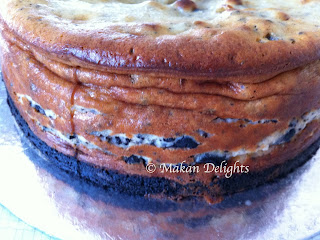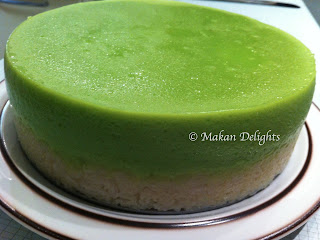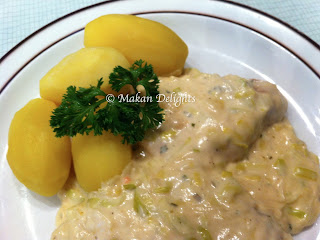The last time, I prepared Chicken Biryani using the mixed spices from "Shan". Today, I prepared Mutton Biryani complete with all the works from scratch. The preparation of the ingredients is a bit tedious and time consuming but the results will make you forget all that. Following recipes serve 4 to 6 persons.
Mutton Biryani Gravy
Ingredients (serves 4 to 6):
1 kg mutton, to be cut into 10 big pieces
6 - 8 medium-size onions, to be peeled and finely sliced
4 stalks of green chillies, to be halved (optional: deseeded)
5 big red tomatoes, to be cut into cubes
2 tbsp tomato puree
50 g joghurt
50 g cashew nuts, to be grounded (or left whole: optional)
50 g coriander leaves, to be plucked
50 g mint leaves, to be plucked
salt to taste
cooking oil
3 tbsp ghee
Biryani Spices:
1 tbsp coriander seeds
1 tsp cumin
1 tsp aniseed
1/4 nutmeg
Note: All the above spices to be fried in a pan without oil until fragrant. Cool completely and grind finely.
Pounded Ingredients:
6 cloves of garlic
3 cm fresh ginger
Method:
Marinate meat with pounded ingredients and biryani spices. Leave aside for about 10 minutes.
Heat cooking oil and ghee in a pot. Add in onion slices and stir-fry until the colour changes to light yellow. Add in marinated meat and cook for about 5 minutes. Then, add in tomato puree and yoghurt. Stir well and cook further for about 5 minutes. Add in green chillies, chopped tomatoes, cashew nuts, coriander leaves and mint leaves. Cook over low heat until meat is tender. Note: Mutton will take at least one hour to cook whereas beef will take a bit longer. Remove meat once tender from pot and simmer gravy until it thickens. Once thickened, return meat to pot and cook for about 10 minutes.
Nasi Briyani (Briyani Rice)
Ingredients (serves 4 to 6):
1/2 kg basmati rice, to be washed and drained
1/2 cup evaporated milk to be mixed with 2 tbsp rose water and a little safran
1/4 cup yoghurt
1/4 cup ghee
2 medium-size onions, to be peeled and finely sliced
30 g coriander leaves, to be plucked
30 g mint leaves, to be plucked
salt to taste
a few drops of liquid yellow colouring
50 g cashew nuts
50 g raisins
fried shallots for garnishing
Pounded Ingredients:
3 cloves of garlic
3 cm fresh ginger
Spices:
3 cm cinnamon stick
3 cloves
3 cardamom
Method:
Measure water according to weight of rice and set aside.
Heat ghee and add sliced onions. Stir-fry until fragrant and then, add in the spices. Stir well and add in pounded ingredients. Cook until fragrant. Add in water, evaporated milk, yoghurt and salt to taste. Let it boil gently. Then, add in rice. Cook until all liquid have evaporated. Stir rice well. Then, add some Biryani Gravy on one corner of rice. Do not stir! Sprinkle yellow colouring. Do not stir. Add coriander leaves, mint leaves, cashew nuts and raisins. Cover pot and cook over very low heat for about 45 minutes to one hour or until rice is cooked.
Once rice is ready, stir gently and serve sprinkled with fried shallots.
Paceri Nenas
Ingredients:
1 sweet pineapple, to be skinned and cut into "diamond" pieces
1/2 tsp turmeric powder
1 big onion, to be finely sliced
3 stalks red chillies, to be sliced finely
4 tbsp sugar
2 tbsp tomato ketchup
1 tbsp white vinegar
salt to taste
cooking oil
Pounded Ingredients:
1 big onion, to be sliced
2 cloves of garlic, to be sliced
1 cm fresh ginger, to be sliced
2 pcs candlenuts, to be soaked in warm water
Spices:
3 cloves
2 cardamom
3 cm cinnamon stick
Method:
Boil water in a pot and add turmeric powder and a little salt. Add in pineapple pieces and let it boil gently. Remove pineapple pieces to a colander.
Heat oil in a pot and add in pounded ingredients and spices. Stir-fry until the colour changes. Then, add in tomato ketchup, sugar, vinegar and salt to taste. Finally, add in pineapple, sliced onions and chillies. Stir well and cook for 5 minutes. Once done, remove from heat.
Acar Timun (Cucumber Pickle)
Ingredients:
1 large cucumber or 2 small cucumbers, to be deseeded and cut into lengths
1 medium-size carrot, to be peeled and cut into fine sticks
2 stalks green chillies, to be halved and deseeded (optional)
2 stalks red chillies, to be halved and deseeded (optional)
10 red shallots, to be peeled and leave whole
5 cloves of garlic, to be peeled and leave whole
1/4 cup white vinegar
4 tbsp sugar
salt to taste
1 tsp black mustard seeds
Pounded Ingredients:
6 stalks red chillies, to be sliced
4 red shallots, to be sliced
3 cloves garlic, to be sliced
1 cm fresh ginger, to be sliced
4 pcs candlenuts, to be soaked in warm water
1 cm fresh turmeric
1 tbsp dried prawns, to be soaked in warm water
Method:
In a bowl, add halved green & red chillies, shallots, garlic, cucumber pieces, carrot sticks and 1 tsp salt. Mix well and leave aside for 30 minutes. Then, wash and drain.
Heat oil in a pot and add pounded ingredients. Stir-fry until fragrant. Then, add in sugar & salt to taste and vinegar. Cook until gravy thickens. Add in the rest of the ingredients and remove from heat.
Serve Mutton Biryani as shown above!
Bon Appetit!





















